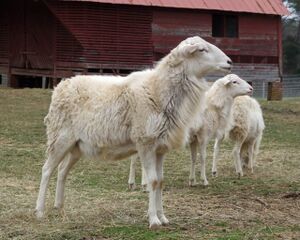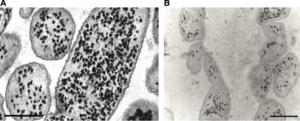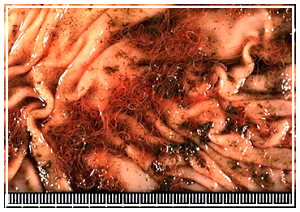Hair Sheep
Introduction
Hair sheep are a breed of sheep characterized by their coat composed of more hair fibers than wool fibers, the characteristic in which they differ from domesticated wool sheep. It is currently estimated that hair sheep make up about 7-10% of the world sheep population.[1] There are two classes of hair sheep: true hair breeds and composite breeds. True hair breeds originated from, and are found in tropical climates. True hair sheep have pure hair coats and exhibit the main characteristics of hair sheep such as parasite resistance, efficient reproduction, and slow growth. Composite breeds of hair sheep are crosses between pure hair breeds and wool breeds. They are characterized by their mix of hair breed characteristics and wool breed characteristics. Therefore, on average, composite breeds grow faster than hair breeds, have heavier muscle mass, and are less parasite resistant. Hair sheep belong to the taxonomic class Mammalia, which contains other domesticated wool sheep as well as all other mammals. Specifically, they belong to the subgroup Caprinae, which also contains goats and horned sheep. There are several species of hair sheep including the Barbados Blackbelly, the St. Croix, the Wiltshire Horn, the Katahdin, the Dorper, and the Royal White. These species are separated mostly by their origin location. However, some of these are composite breeds, and are therefore classified by the breeds bred together to create them.

Evolution
Although the exact date is unknown, it is hypothesized that hair sheep originated in the early 16th century, beginning with the St. Croix breed. All sheep breeds, both hair breeds and wool breeds, share the same ancestral source; the Mouflon sheep.[2] All breeds have 27 pairs of chromosomes, allowing for crossbreeding. Each breed of hair sheep originated at different times and in different places. The Barbados Blackbelly can be traced back to Africa where an unknown European wool breed was crossed with an African hair sheep. Sheep produced from this cross with high quality meat and heat tolerance were then genetically selected for, resulting in a new breed. The Dorper sheep were produced from a cross between a Dorset Horn wool sheep and a Blackhead Persion hair sheep in South Africa. Offspring tolerant to arid conditions were genetically selected for. The Katahdin sheep were produced in Maine from a cross of three african hair sheep from St. Croix and several different wool breeds. Hardy, adaptable, low maintenance, and parasite resistant offspring were then genetically selected for. The St. Croix sheep originated in the British Virgin Islands and are speculated to be a cross between Wiltshire Horn and Criollo sheep. Natural and human genetic selection has led to the sheep being adaptable to climate, fertile, parasite resistant, and docile. This breed has especially desirable adaptations for tropical regions.
Microbiome
Hair sheep, like wool sheep, are ruminants. They have a rumen, the compartment of the stomach responsible for cellulose degradation. The rumen in adult sheep holds 2-3 gallons and is composed of solid, liquid, and epithelial fractions. The solid fraction consists of ingested feed and is colonised by feed adherent microbes that breakdown fibrous matter. The liquid fraction consists of fluid that provides an environment for the free living microbes that are important for the metabolism of nutrients. The epithelial fraction consists of the epithelial lining of the rumen and holds microbes that are involved in tissue recycling, oxygen scavenging, and urea hydrolysis.[3] The reticulorumen is the rumen and reticulum system and serves as a habitat for bacterial and protozoal digestion. The rumen is the ideal habitat for anaerobic microorganisms, with a temperature between 38 and 40 degrees Celsius and a pH between 5.5 and 6.9. Not all species of microorganisms in the rumen are identified yet, but there are several fibrolytic bacteria that are of note. Ruminococcus flavefaciens is a Gram-positive bacteria that was isolated 70 years ago and is known to have high activity against crystalline cellulose. Fibrobacter succinogenes is a Gram-negative bacteria found to digest more plant matter than other bacteria with high activity in digesting cell wall components such as xylans.

Butyrivibrio fibrisolvens is a Gram-positive bacteria that plays an important role in plant fiber digestion.[4] Other bacteria found in the rumen include bacteria from the genera Prevotella, Butyrivibrio, Ruminococcus, Bacteroidales, and Clostridiales. Anaerobic fungi is also found in the rumen and plays a role in the initial degradation of plant particles preceding fibrolytic bacteria activity. The anaerobic fungi known to be found in the rumen include: Piromyces communis, Piromyces mae, Piromyces minutus, Piromyces dumbonicus, Piromyces rhizinflatus, Piromyces spiralis, Piromyces citronii, Anaeromyces elegans, Piromyces polycephalus, Anaeromyces mucronatus, Caecomyces communis, C. equi, C. sympodialis, C. aberensis, C. icaris, Neocallimastix frontalis, and N. patriciarum. The protozoa in the rumen are not well documented, but are shown to be involved in plant cell wall breakdown. The protozoa in the rumen include: Entodinium bovis, E.bursa, E.caudatum, E. parvum, E. dubardi, Epidinium caudatum, Isotricha prostoma, Isotricha intestinalis, Dasytricha ruminantium, Diplodinium dendatum, Oligoisotricha bubali, Eremoplastron asiaticus, Eremoplastron bubalus, Entodinium bubalum, and Entodinium chatterjeei.[5] Methanogens are another class of microbes found in the rumen. Methanogens are important due to their impact on the atmosphere through methane production. The number of protozoa and methane emissions are known to have a positive correlation. There is ongoing research on the importance of protozoa in ruminants and if the elimination of some protozoa could impact methane emissions.[6]
Unique Features and Adaptations
Hair sheep have several unique features that characterize their popularity in the agricultural world. Hair sheep do not produce wool, and therefore do not need to be sheared, docked, or crutched. This cuts down on spending costs for workers in the agricultural industry, and negates the need to find sheep shearers, which have become less common. On average, hair sheep have lower average rectal temps, respiration rates, DMI (dry matter intake), and water intakes than wool breeds. These characteristics lower spending costs, and contribute to hair sheep being a popular choice for sustainable farming. Hair sheep are not heat tolerant due to their lack of wool, but rather their adaptations to hot environments with modifications of their energy pathways and body size.[7]
Not only do hair sheep require less resources, but they also have higher fertility, prolificacy, and lamb survival on average than wool breeds. Hair and wool breed crosses have higher levels of fertility on average than their hair and wool breed parents.[8] Hair sheep breed seasonally in the US but perform better under accelerated lambing systems than wool breeds do. All of these adaptations are important for the farming industry, but arguably the most important adaptation in the hair sheep is parasite resistance. The most limiting factor to raising sheep in pasture is gastrointestinal nematodes, also known as worms.

Haemonchus contortus is a common parasite known to affect ruminants, and is often responsible for the death of lambs and ewes. Lambs often die due to anemia, reduced appetite, slower growth, and a compromised immune system that is susceptible to other diseases. In ewes, parasites reduce fertility and milk production. Hair sheep tend to develop immunity to parasites earlier than wool breeds, displaying immunity between 3-4 months of age in comparison to the 5-7 month range of wool breeds. When comparing hair and wool lambs infected with the parasite H. contortus, hair lambs produce more immunoglobulin A than wool lambs, suggesting better immunity against parasite infection It is unclear whether all hair breeds express innate resistance, but this has been observed in the Katahdin breed. Resistance appears to be inheritable. Around 20-25% heritability is observed in wool breeds, and around 40-50% heritability is observed in hair breeds. Resistance is inherited on multiple genes and animals with multiple generations of resistance more consistently pass on the trait. Resistance genes are selected for by identifying potentially resistant animals and breeding them. It is important to note that on average, hair sheep are more resistant than wool sheep, but both populations have some resistant and susceptible individuals. Also, resistance is not complete, even sheep with resistance have some parasites.
Conclusion
Due to their key adaptations, hair sheep are economically beneficial and sustainable to raise. Sheep shearers are difficult to find, so the lack of wool in hair sheep saves money and effort. Sheep and cows have different grazing preferences, so hair sheep can be raised in conjunction with cows in dairy and beef operations. Hair sheep have less problems with internal parasites and therefore are at less risk of death, and also do not experience symptoms of infection such as reduced fertility. Hair sheep can also be raised in the southern United States because of their tolerance for heat and humidity. Purebred hair breeds often tend to be small and poorly muscled, leading to the need for hair and wool breed crosses.[9] Global warming and agricultural land shrinkage, as well as increase in human population has led to the need for efficient and sustainable production of food animals, the niche for which hair sheep are bred.
References
- ↑ Fitzhugh HA, Bradford GE. Productivity of Hair Sheep and Opportunities for Improvement. CRC Press eBooks. 2019 May 20;23–52.
- ↑ Dearborn L, Bakeerah Abdul-Rahmaan, Pesato M, Erdogan Memili, Rios L. Hair sheep in the Americas: economic traits and sustainable production. Frontiers in animal science. 2023 Dec 7;4.
- ↑ McLoughlin S, Spillane C, Campion FP, Claffey N, Sosa CC, McNicholas Y, et al. Breed and ruminal fraction effects on bacterial and archaeal community composition in sheep. Scientific reports.2023 Feb 27;13(1).
- ↑ Pavel Kalač. A brief overview of the chain forage–milking animal–milk. Elsevier eBooks Internet 2017 Jan 1 cited 2024 Dec 11;7–22.
- ↑ Arjun S, Neha P, Mohith Sai SR, Ravi L. Microbial symbionts in ruminants. Academic Press; 2023. p. 493–509.
- ↑ Morgavi DP, Forano E, Martin C, Newbold CJ. Microbial ecosystem and methanogenesis in ruminants. animal. 2010 Apr 13;4(7):1024–36.
- ↑ CM, Faria DA, Lucci CM, Louvandini H, Pereira SA, Paiva SR. Heat stress effects on sheep: Are hair sheep more heat resistant? Theriogenology. 2020 Oct;155:157–67.
- ↑ S. Hair sheep genetic resources and their contribution to diversified small ruminant production in the United States. Journal of Animal Science 1997 Mar 1 cited 2020 Dec 4;75(3):630–40
- ↑ Notter DR. Potential for Hair Sheep in the United States. Journal of Animal Science. 2000 Jan 1;
Edited by Sophia Carling, student of Joan Slonczewski for BIOL 116, 2024, Kenyon College.
